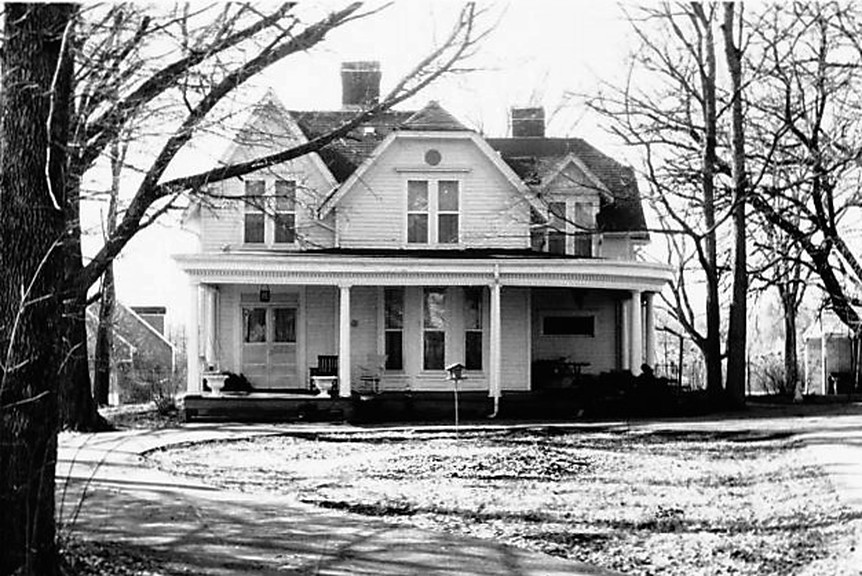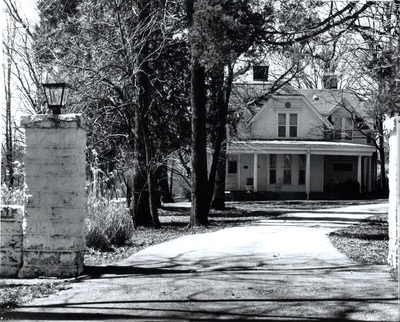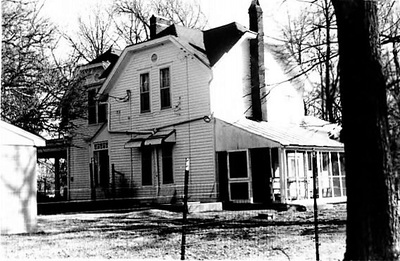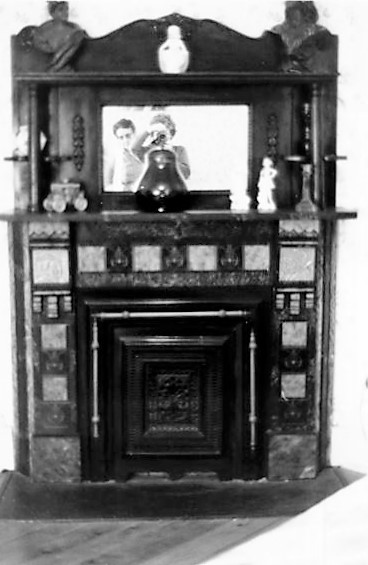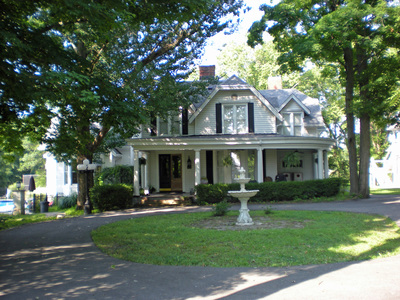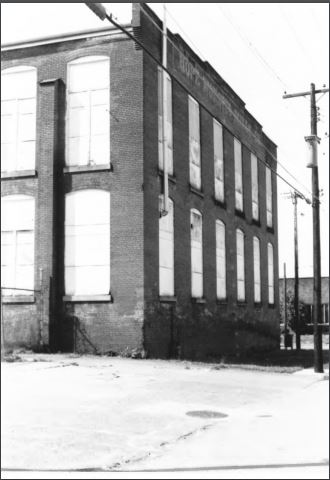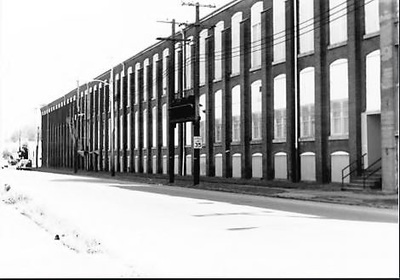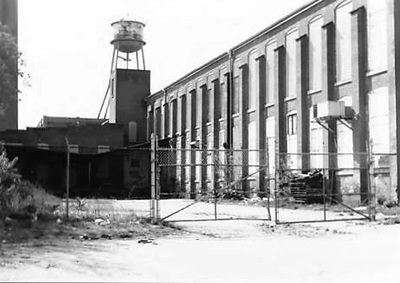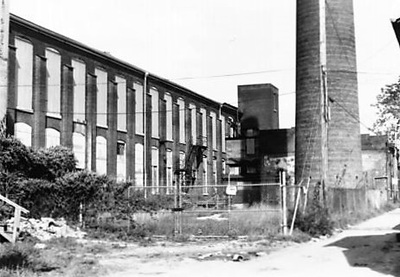Joseph H. Ellis House
This National Historic Register property was individually nominated to the National Register of Historic Places as part of the Historic Resources of Pewee Valley Multiple Property Listing. Located on Maple Avenue, the submission notes it was either built “… or substantially remodeled about 1890…Located in the area of town laid out in 1866 by Henry Smith, the property provides one of the few remaining intact examples of pre-1900 houses… (and) is representative of the large rambling residences …influenced by the town’s new Queen Anne style hotel, the Villa Ridge Inn, built in 1889.
Deed research indicates that William R. Shelby purchased the first of several pieces of land associated with this property from James F. Smith, nephew and son-in-law of Henry Smith, in 1875. An 1879 map shows a house with Shelby’s name on the site. In 1889 Joseph H. Ellis purchased the then nine-acre property from Shelby for $2500. Based on stylistic analysis and the large jump in the property price (reported in the deeds), it is presumed that Ellis built or drastically altered the house during the next 12 years."
Deed research indicates that William R. Shelby purchased the first of several pieces of land associated with this property from James F. Smith, nephew and son-in-law of Henry Smith, in 1875. An 1879 map shows a house with Shelby’s name on the site. In 1889 Joseph H. Ellis purchased the then nine-acre property from Shelby for $2500. Based on stylistic analysis and the large jump in the property price (reported in the deeds), it is presumed that Ellis built or drastically altered the house during the next 12 years."
The Ellis Years
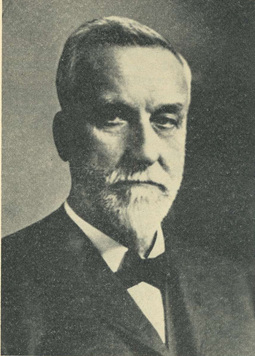 Milton Hannibal Smith, President of the L&N Railroad. His brother, Horace F. Smith, developed the Villa Ridge Hotel in Pewee Valley.
Milton Hannibal Smith, President of the L&N Railroad. His brother, Horace F. Smith, developed the Villa Ridge Hotel in Pewee Valley.
Joseph H. Ellis was an officer with the Louisville and Nashville Railroad and served as Fourth Vice President under the very popular president Milton H. Smith. Quite a few L&N employees were full-time residents or had summer homes in Pewee Valley at the turn of the 20th century. The railroad was a major employer of the town’s African-American population, as well.
Milton Smith, himself, leased a home in Pewee for at least one summer and later, may have owned a country estate here, according to the following news briefs in the Earlington Bee:
May 27, 1897
President Milton Smith, of the L. & N. railway, has leased the Swearingen place at Pewee Valley and will shortly move out his family for the summer.
September 16, 1897
Felder-Smith
Louisville, Ky. Sept. 13. The marriage of Miss Nettie Belle Smith to Mr. Thomas J. Felder took place this afternoon at Pewee Valley, the country home of the bride's father, Milton H. Smith, President of the Louisville and Nashville Railroad. The wedding was quiet, the only guest being Miss Duvall of Frankfort. Tbe ceremony was performed by the Rev. S. M. Hamilton, pastor of the Warren Memorial Presbyterian Church. There were no attendants, and soon after the ceremony Mr. and Mrs. Felder left in a private car to Chicago.
The Ellises evidently lived in the home summer and winter. A story called, “The Winter Colony at Pewee Valley,” published in the November 28, 1897 Courier-Journal, numbered the Ellises among the town’s permanent residents and also noted that Mr. Ellis was president of the Shakespeare Club and known for his fine library.
The Ellis family appears to have moved to Knoxville, Tenn., following a promotion Joseph received at the L&N. The November 2, 1902 Courier-Journal carried the following story about his new title and job:
J.H. ELLIS ASSUMES
DUTIES OF NEW POSITION.
________
Issues Circulars Announcing appointments On the Atlanta, Knoxville and Northern
Knoxville, Tenn., Nov. 1 – (Special) ---
J.H. Ellis to-day assumed his duties as vice president and general manager of the Atlanta, Knoxville and Northern branch of the Louisville and Nashville railroad. He at once issued a circular announcing these appointments: R. Montford, chief engineer, office at Louisville; W.H. Courtenay, principal assistant engineer, office at Louisville; C.W Bradley, superintendent, office at Blue Ridge, Ga.; N.H. Brown, master of trains, office at Blue Ridge, Ga. Mr. Bradshaw arrived yesterday from Russellville, Ky., and began his duties today.
Another circular announces the appointement of W.H. Bruce as secretary of the Knoxville, LaFolette and Jellico, to succeed J.H. Ellis. Another circular names E.L. Smithers, of New York, as transfer agent of Atlanta, Knoxville and Norther. J.H. Ringgold, formerly of Louisville, is Mr. Ellis’ chief clerk.
The Stine Years
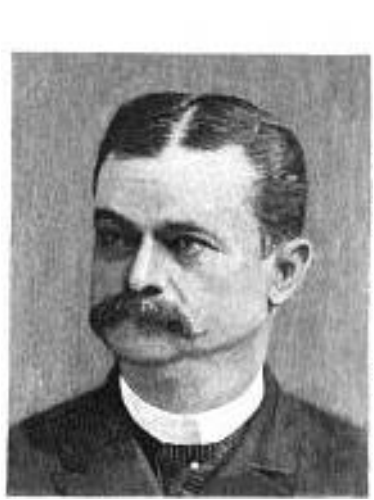 Maj. J.W. Stine
Maj. J.W. Stine
In 1902, J.W. Stine, Jr. and his wife, Julia Omberg Stein, purchased the house for $4,630 and it remained in their possession for 13 years. J.W. was the son of Louisville industrialist Major J. W. Stine. A profile of Stine, Sr. appeared in “The City of Louisville and a Glimpse of Kentucky,” published under the direction of the Committee on Industrial and Commercial Improvement of the Louisville Board of Trade in 1887:
… Major J. W. Stine has long been a leading spirit in all that has been undertaken for the development of Louisville. He connected himself with the enterprise in its darkest days, and to his courage and genius a very large share of its present success and prosperity is attributable. He was born in Baltimore, Maryland, but removed to Newport, Kentucky, in 1859. He entered the federal service with the Cincinnati Zouaves, of which he was an officer. He left the army in 1863 and, after a brief mercantile venture in the interior of Kentucky, came to Louisville in 1864 and became a member of the firm of W. B. Leonard & Co., then in the grain business. A short time afterward, he purchased a share in the Hope Woolen Mills, since which time he has devoted himself unremittingly to the "Kentucky jeans manufacture." He now partly controls and manages the Louisville (Kentucky) Woolen Mills, one of the largest manufactories of Louisville, and the most extensive establishment of its kind in the world. Major Stine has been most fortunate in all his enterprises. He is public spirited to a high degree, and has been honored by election to many offices of trust. In the Expositions, new and old, he was an active spirit and officer. For five years he was a member of the Board of Directors of the Board of Trade, and for two years a member of the council from the Second Ward. He was elected to the council in the memorable Baxter-Jacob contest. The ward voted for Baxter, but on account of Major Stine's great personal popularity, though being the Jacob candidate, he carried the ward by a handsome majority.
A description of the mills’ operations appeared in the November 6, 1890 issue of Wade’s Fiber and Fabric: A Record of American Textile Industries in the Cotton and Woolen Trade, Volume 12, as part of comprehensive coverage of Louisville’s burgeoning textile industry:
I have found more prosperity to the square inch in and about the woolen mills of this busy city than I have ever met with during the past year in any manufacturing city of equal proportions which I have visited. The first worsted yarn spinning mill ever started south of Mason and Dixon's line is here. It is called the Pioneer worsted mills, a very appropriate name. Mr. L. Richardson is president: J. W. Stine, vice-president; Walker Richardson, treasurer, and R. M. Cunningham, secretary. They report business good. The Messrs. Richardson are members of the greatest wool buying firm in this section; and Major Stine is, beyond a doubt, the busiest man in Louisville. Besides having the full responsibility of the management of the Louisville woolen mills resting upon his shoulders, he has a heavy interest in the worsted mill, and Louisville and Madison woolen mills, besides outside corporations, railroads, etc., which take up every minute of his spare time. He has been engaged in the woolen manufacturing business here for 27 years, and is one of the early pioneers in. this line in the south and west.
Ca. 1996 Hope Worsted Mills Photos from the National Register of Historic Places Nomination
Textiles were a booming business at the Falls of the Ohio after the War Between the States, according to the Hope Worsted Mills National Register nomination form:
In the years following the Civil War, the steam boat operations and expansion of the rail system in Louisville developed quickly, with an opportunistic eye to securing the Southern market that had been decimated by the war. With the L & N Railroad, Louisville succeeded in gaining contact with every city within 300 miles. The textile industry was a growing business enmeshed in this expansion.
By November 1866, three cotton firms were conducting daily sales. The market grew steadily, and during the 1867-68 cotton season more than 100,000 bales were shipped via the L & N rail line (Rail Routes South, pg. 25). Especially significant as an export from Louisville was the production of Kentucky jeans and jeans cloth. The 1880 Census reported that Kentucky was the nation's second largest producer of jeans cloth…
…In 1877 Louisville's textile manufacturing was a 2.25 million dollar industry involving almost 7.5 million yards of cloth. By 1887 the industry experienced a tenfold increase.
Major Stine died in 1896 and his death was mourned not only by his family and those who worked with him at the woolen mills and the railroad, but also by many friends and admirers. He appears to have been a very popular and well-liked man. His obituary ran in the July 6, 1896 issue of the Courier-Journal:
DEATH
________
Comes to Maj. J.W. Stine
After Short Illness
________
SICK BUT THREE WEEKS
_________
WAS PRESIDENT OF THE LOUISVILLE WOOLEN MILLS
________
PROMINENT BUSINESS MAN
Maj. J.W. Stine, one of Louisville’s most substantial and prominent business men, died shortly after last midnight at the Louisville Training School in Beechmont, on the Southern parkway, two miles from the city, where he was spending the summer.
Maj. Stine has been ill of kidney trouble for three weeks. His condition became serious last Thursday and he gradually grew worse till the end came early this morning. The attending physicians realized yesterday that death was near and the members of Maj. Stine’s family gathered around his bedside and watched his life ebb away.
Maj. Stine has been identified with the business interests of Louisville for years. At the time of his death he was President of the Louisville Woolen Mills, a director of the First National Bank and President of the Hope Worsted Mills. He was also interested in a number of smaller enterprises.
Maj. Stine was prominently identified with the building of the Southern railroad. He led an active life and massed a considerable fortune.
He was sixty-one years of age and was born in Baltimore, Md. He moved to Harrisburg, Pa., where he engaged in business before coming to Louisville. His rise was rapid and he soon became prominent in the business circles of this city.
He was married to Miss Nannie Baker, of Louisville, who survives him. The funeral arrangements will be made today. Maj. Stine leaves three children – Mr. J.W. Stine, Jr., Mrs. Curd M. Bridges and Miss Sweetie Stine.
His funeral notice was carried in the next day’s paper, along with resolutions from the directors of the Louisville Woolen Mills and from members of Calvary Church:
FUNERAL OF MAJ. STINE.
________
Services To Be Held in Calvary
Church at 4 O’Clock This
Afternoon.
________
The funeral of Maj. J.W. Stine, who died at Beechmont shortly after midnight yesterday morning of kidney trouble, will take place this afternoon at 4 o’clock from Calvary church. Rev. J.G. Minnigerode will conduct the services. The interment will be in Cave Hill Cemetery. The active pallbearers will be as follows: Alvah Terry, John Moore, George A. Robinson, Clinton McClarty, B. Gallatti, William Matthews, John B. Baskin and John C. Hughes.
The honorary pallbearers will be: Col. Thomas W. Bullitt, Col. Bennett H. Young, J.W. Ainslee, Dr. George W. Lewman, J.H. Lindenberger, Thomas Maize, A. E. Richards, Tobe Hurt. Hon. Charles D. Jacob, Charles Murphy, A.B. Cooper and Charles Grubbs.
Copy of Resolutions Adopted By the Directory of the Louisville Woolen Mills
A meeting of the directory of the Louisville Woolen Mills was called this 6th day of July, 1989 in view of the death of Mr. John W. Stine, manager and treasurer of the company, which occurred today, and the following resolutions were unanimously adopted:
Resolved, That we are filled with sincere sorrow and the deepest regret by the death of our beloved friend and business associate, Mr. John W. Stine.
That we desire to record our high appreciation of his energy and ability as an officer in this country during the sixteen years of our intimate intercourse. Active in this relation, he found time to take part in varied public enterprises in the interest of his adopted city, to which he was devoted, and in many benevolent efforts for the welfare of his fellow -men.
He will be sadly missed in our company by his associate officers and by our employees; in general business affairs; in the positions of trust which he held; by his wide circle of friends as a liberal and public-spirited citizen; and in the church of which he was a member and offerer.
That we beg leave to assure his bereaved family of our tenderest sympathy for them in their time of distress and great loss.
That these resolutions be placed on the records of this company and a copy sent to the family of our deceased friend.
JAS. W. AINSLIE, President
GEO. A ROBINSON, V. Pres.
ARCH M. ROBINSON, Secretary
Resolutions on the Death of J.W. Stine.
The vestry of Calvary church have heard the feelings of profound sorrow of the death of their co-worker and friend, John W. Stine. They wish to place upon record their high appreciation of his character and manly virtues, his single-hearted devotion to the church he served so faithfully. His enthusiastic zeal, sound judgment and open-handed liberality will be sorely missed.
As a public-spirited citizen his name will be found on the lips of many eager to speak his biography; as a kind and generous friend his memory will be held in grateful recollection; as a soldier of the Great King and vestryman in the church he has received his promotion, has laid aside his armor for the spotless robes of righteousness of that Savior in whom he trusted.
To the partner of his life and love and his bereaved children we tender our heart-felt sympathy.
May the widow’s God and the Father of the fatherless be their support and comfort.
J.G. MINNIGERODE, Rector
E.H. BOWEN, Registrar
He is buried in Cave Hill Cemetery beside his wife, Nannie, who died in June 1909.
In the years following the Civil War, the steam boat operations and expansion of the rail system in Louisville developed quickly, with an opportunistic eye to securing the Southern market that had been decimated by the war. With the L & N Railroad, Louisville succeeded in gaining contact with every city within 300 miles. The textile industry was a growing business enmeshed in this expansion.
By November 1866, three cotton firms were conducting daily sales. The market grew steadily, and during the 1867-68 cotton season more than 100,000 bales were shipped via the L & N rail line (Rail Routes South, pg. 25). Especially significant as an export from Louisville was the production of Kentucky jeans and jeans cloth. The 1880 Census reported that Kentucky was the nation's second largest producer of jeans cloth…
…In 1877 Louisville's textile manufacturing was a 2.25 million dollar industry involving almost 7.5 million yards of cloth. By 1887 the industry experienced a tenfold increase.
Major Stine died in 1896 and his death was mourned not only by his family and those who worked with him at the woolen mills and the railroad, but also by many friends and admirers. He appears to have been a very popular and well-liked man. His obituary ran in the July 6, 1896 issue of the Courier-Journal:
DEATH
________
Comes to Maj. J.W. Stine
After Short Illness
________
SICK BUT THREE WEEKS
_________
WAS PRESIDENT OF THE LOUISVILLE WOOLEN MILLS
________
PROMINENT BUSINESS MAN
Maj. J.W. Stine, one of Louisville’s most substantial and prominent business men, died shortly after last midnight at the Louisville Training School in Beechmont, on the Southern parkway, two miles from the city, where he was spending the summer.
Maj. Stine has been ill of kidney trouble for three weeks. His condition became serious last Thursday and he gradually grew worse till the end came early this morning. The attending physicians realized yesterday that death was near and the members of Maj. Stine’s family gathered around his bedside and watched his life ebb away.
Maj. Stine has been identified with the business interests of Louisville for years. At the time of his death he was President of the Louisville Woolen Mills, a director of the First National Bank and President of the Hope Worsted Mills. He was also interested in a number of smaller enterprises.
Maj. Stine was prominently identified with the building of the Southern railroad. He led an active life and massed a considerable fortune.
He was sixty-one years of age and was born in Baltimore, Md. He moved to Harrisburg, Pa., where he engaged in business before coming to Louisville. His rise was rapid and he soon became prominent in the business circles of this city.
He was married to Miss Nannie Baker, of Louisville, who survives him. The funeral arrangements will be made today. Maj. Stine leaves three children – Mr. J.W. Stine, Jr., Mrs. Curd M. Bridges and Miss Sweetie Stine.
His funeral notice was carried in the next day’s paper, along with resolutions from the directors of the Louisville Woolen Mills and from members of Calvary Church:
FUNERAL OF MAJ. STINE.
________
Services To Be Held in Calvary
Church at 4 O’Clock This
Afternoon.
________
The funeral of Maj. J.W. Stine, who died at Beechmont shortly after midnight yesterday morning of kidney trouble, will take place this afternoon at 4 o’clock from Calvary church. Rev. J.G. Minnigerode will conduct the services. The interment will be in Cave Hill Cemetery. The active pallbearers will be as follows: Alvah Terry, John Moore, George A. Robinson, Clinton McClarty, B. Gallatti, William Matthews, John B. Baskin and John C. Hughes.
The honorary pallbearers will be: Col. Thomas W. Bullitt, Col. Bennett H. Young, J.W. Ainslee, Dr. George W. Lewman, J.H. Lindenberger, Thomas Maize, A. E. Richards, Tobe Hurt. Hon. Charles D. Jacob, Charles Murphy, A.B. Cooper and Charles Grubbs.
Copy of Resolutions Adopted By the Directory of the Louisville Woolen Mills
A meeting of the directory of the Louisville Woolen Mills was called this 6th day of July, 1989 in view of the death of Mr. John W. Stine, manager and treasurer of the company, which occurred today, and the following resolutions were unanimously adopted:
Resolved, That we are filled with sincere sorrow and the deepest regret by the death of our beloved friend and business associate, Mr. John W. Stine.
That we desire to record our high appreciation of his energy and ability as an officer in this country during the sixteen years of our intimate intercourse. Active in this relation, he found time to take part in varied public enterprises in the interest of his adopted city, to which he was devoted, and in many benevolent efforts for the welfare of his fellow -men.
He will be sadly missed in our company by his associate officers and by our employees; in general business affairs; in the positions of trust which he held; by his wide circle of friends as a liberal and public-spirited citizen; and in the church of which he was a member and offerer.
That we beg leave to assure his bereaved family of our tenderest sympathy for them in their time of distress and great loss.
That these resolutions be placed on the records of this company and a copy sent to the family of our deceased friend.
JAS. W. AINSLIE, President
GEO. A ROBINSON, V. Pres.
ARCH M. ROBINSON, Secretary
Resolutions on the Death of J.W. Stine.
The vestry of Calvary church have heard the feelings of profound sorrow of the death of their co-worker and friend, John W. Stine. They wish to place upon record their high appreciation of his character and manly virtues, his single-hearted devotion to the church he served so faithfully. His enthusiastic zeal, sound judgment and open-handed liberality will be sorely missed.
As a public-spirited citizen his name will be found on the lips of many eager to speak his biography; as a kind and generous friend his memory will be held in grateful recollection; as a soldier of the Great King and vestryman in the church he has received his promotion, has laid aside his armor for the spotless robes of righteousness of that Savior in whom he trusted.
To the partner of his life and love and his bereaved children we tender our heart-felt sympathy.
May the widow’s God and the Father of the fatherless be their support and comfort.
J.G. MINNIGERODE, Rector
E.H. BOWEN, Registrar
He is buried in Cave Hill Cemetery beside his wife, Nannie, who died in June 1909.
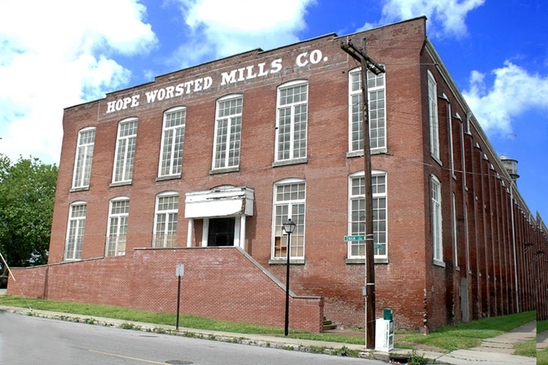 The Hope Worsted Mills building is still standing in Louisville's Germantown neighborhood.
The Hope Worsted Mills building is still standing in Louisville's Germantown neighborhood.
A remnant of Maj. Stine’s textile business is still extant at the Hope Worsted Mills building, 942 E. Kentucky St., in Louisville’s Germantown neighborhood. The 83,000-square-foot, two-story, brick factory was placed on the National Register of Historic Places in 1996.
Originally, Hope Worsted Mill was located on Logan Street, near Pilcher Organ, Ferncliffe Distilling Company and Sengel Cooperage. Built in 1904, eight years after Maj. Stein’s death, the new factory offered a better location and improved access to rail transportation.
The August 18, 1898 issue of United States Investor and Promoter of American Enterprises, Volume 9, Part 2, Issues 27-52 carried the following story, which noted that Stine, Jr. was elected to Stine, Sr.’s position at the mill following his father’s death; however, Stine, Jr.’s obituary noted he had sold his interest in the Hope Worsted Mill around 1902, two years after the new factory opened. It was evidently not a success and went out of business in 1909.
LOUISVILLE, KY., Aug. 18. 1898. The wool market after a long period of inaction is waking up. Buying from the Bast has begun, though in a moderate fashion, and mills here are beginning to take liberally of local stocks. These sales are quite large.as they will aggregate about two million pounds, though it is impossible to state them accurately. Jobbers bought liberally directly after shearing time, and they might have had much more on hand but for the fact that the clip fell fully 40 per cent short of the average. This was somewhat of a surprise, as it was thought farmers had recruited their flocks. It turned out that this was only true of the blue grass section, in most of the state there is as much indifference to sheep now as ever, though lamb growing is steadily becoming more popular, and the trade in mutton larger.
THE JEANS MILLS
here are now receiving liberal orders, and are generally running on full time. Many of them worked short hours during most of the summer, and this was also the case with one yarn mill, which ran but five days a week, though now going at full time. The mills which manufacture cassimeres have done reasonably well. The worsted mills have been kept busy all the time. The Hope mills suffered the loss of their president, Mr. J. W. Stine, a short time ago. His son, Mr. J. W. Stine, Jr., who had been brought up in the business, and trained by his father, was the active manager of the mills, and has been elected vice-president and general manager. He had previously been treasurer and manager. Mr. Charles F. Murphy, of Boston, who had been vice-president, was promoted to the presidency, and J. T. Moore, former secretary, was elected secretary and treasurer. Young Mr. Stine had formerly filled the office of treasurer.
The rearrangement of the offices and officers is in accordance with the best interests of the mills. The Hope has always been a prosperous corporation.
The elder J. W. Stine was the vice president and director of the Louisville woolen mills, and his death made a general shifting necessary there. His son was chosen to succeed him in the vice-presidency, and also in the directory. Mr. J. W. Ainslee was re-elected president; Mr. George A. Robinson, general manager, and Arch M. Robinson, secretary and treasurer. These have long been connected with the mill, and their continuance is a guarantee of its further success.
The Stines used their Pewee Valley house as their full-time residence, rather than as a summer home. An incorporation notice for Stine & Osborne appeared in the Industrial Development and Manufacturers’ Record, Volume 48, published in 1905 by Conway Publications, gave his home as Pewee Valley:
Louisville—Acetylene-gas Machines – Stine & Osborn Company. reported incorporated in July with $10,000 capital stock to deal in acetylene-gas machines, has completed organization with J. W. Stine of Pewee Valley, Ky., president and treasurer, and L. C. Osborn of Louisville, vice-president and secretary; 156-158 East Main street.
J.W. Stine, Jr. died on August 17, 1910. He was only 44 years old. His obituary ran in the August 18 Courier-Journal:
J.W. STINE DEAD
WAS IDENTIFIED WITH WOOL-
EN MILLS BUSINESS
________
Son of Late Maj. J.W. Stine, Onf
Of Louisville’s Former Capi-
talists
________
John William Stine, 44 years of age, who was a retired business man of Louisville, died at 6:15 o’clock yesterday morning, at his home near Pewee Valley. Death followed an illness lasting two years as a complication of diseases. His death was unexpected.
Several weeks ago Mr. Stine was taken violently ill and was forced to take to his bed. His condition changed for the better several days afterward, and it was expected that he would fully recover. A few days ago he suffered another sick spell. He was taken abed again and his condition gradually grew worse. Tuesday night he began sinking to his end and he passed away early yesterday morning.
Mr. Stein was one of the founders of the Hope Worsted Mills. In 1892, Charles Murphy, of Boston, Mass. and he organized the company. After acting as vice president of the company for eight years he disposed of his holdings and retired. Since that time he lived quietly at his home near Pewee Valley.
Mr. Stine was a native of Louisville and was the son of Maj. J.W. Stine, one of the promoters of the Southern Railway Company and Kentucky & Indiana Bridge Company. He received his education in the schools of Louisville, being graduated from the Male High School.
He married Miss Julia Omberg, daughter of Capt. William Omberg, in 1890. Besides his wife he is survived by two sisters, Mrs. James M. Holloway of New York, and Mrs. C.M. Bridges of Louisville. He was a Mason and a member of the St. James Episcopal church, of Pewee Valley.
The funeral will take place at the residence at 10:15 o’clock this morning, with burial at Cave Hill Cemetery.
The following will act as pallbearers: James F. Buckner, Jr. (editor’s note: he lived in the Thomas C. Peebles House on Maple); Thomas F. Smith; Charles R. Long, Jr.; Charles V. Norton; Matt Warfield (editor’s note: presumably Nate or Nathaniel Warfield who lived off Rest Cottage Lane); Fred Breyfogle, Dr. Frank Simson, Dr. R. Hays Davis and Alex Craig (editor’s note: he lived in Edgewood, off Central Avenue).
Originally, Hope Worsted Mill was located on Logan Street, near Pilcher Organ, Ferncliffe Distilling Company and Sengel Cooperage. Built in 1904, eight years after Maj. Stein’s death, the new factory offered a better location and improved access to rail transportation.
The August 18, 1898 issue of United States Investor and Promoter of American Enterprises, Volume 9, Part 2, Issues 27-52 carried the following story, which noted that Stine, Jr. was elected to Stine, Sr.’s position at the mill following his father’s death; however, Stine, Jr.’s obituary noted he had sold his interest in the Hope Worsted Mill around 1902, two years after the new factory opened. It was evidently not a success and went out of business in 1909.
LOUISVILLE, KY., Aug. 18. 1898. The wool market after a long period of inaction is waking up. Buying from the Bast has begun, though in a moderate fashion, and mills here are beginning to take liberally of local stocks. These sales are quite large.as they will aggregate about two million pounds, though it is impossible to state them accurately. Jobbers bought liberally directly after shearing time, and they might have had much more on hand but for the fact that the clip fell fully 40 per cent short of the average. This was somewhat of a surprise, as it was thought farmers had recruited their flocks. It turned out that this was only true of the blue grass section, in most of the state there is as much indifference to sheep now as ever, though lamb growing is steadily becoming more popular, and the trade in mutton larger.
THE JEANS MILLS
here are now receiving liberal orders, and are generally running on full time. Many of them worked short hours during most of the summer, and this was also the case with one yarn mill, which ran but five days a week, though now going at full time. The mills which manufacture cassimeres have done reasonably well. The worsted mills have been kept busy all the time. The Hope mills suffered the loss of their president, Mr. J. W. Stine, a short time ago. His son, Mr. J. W. Stine, Jr., who had been brought up in the business, and trained by his father, was the active manager of the mills, and has been elected vice-president and general manager. He had previously been treasurer and manager. Mr. Charles F. Murphy, of Boston, who had been vice-president, was promoted to the presidency, and J. T. Moore, former secretary, was elected secretary and treasurer. Young Mr. Stine had formerly filled the office of treasurer.
The rearrangement of the offices and officers is in accordance with the best interests of the mills. The Hope has always been a prosperous corporation.
The elder J. W. Stine was the vice president and director of the Louisville woolen mills, and his death made a general shifting necessary there. His son was chosen to succeed him in the vice-presidency, and also in the directory. Mr. J. W. Ainslee was re-elected president; Mr. George A. Robinson, general manager, and Arch M. Robinson, secretary and treasurer. These have long been connected with the mill, and their continuance is a guarantee of its further success.
The Stines used their Pewee Valley house as their full-time residence, rather than as a summer home. An incorporation notice for Stine & Osborne appeared in the Industrial Development and Manufacturers’ Record, Volume 48, published in 1905 by Conway Publications, gave his home as Pewee Valley:
Louisville—Acetylene-gas Machines – Stine & Osborn Company. reported incorporated in July with $10,000 capital stock to deal in acetylene-gas machines, has completed organization with J. W. Stine of Pewee Valley, Ky., president and treasurer, and L. C. Osborn of Louisville, vice-president and secretary; 156-158 East Main street.
J.W. Stine, Jr. died on August 17, 1910. He was only 44 years old. His obituary ran in the August 18 Courier-Journal:
J.W. STINE DEAD
WAS IDENTIFIED WITH WOOL-
EN MILLS BUSINESS
________
Son of Late Maj. J.W. Stine, Onf
Of Louisville’s Former Capi-
talists
________
John William Stine, 44 years of age, who was a retired business man of Louisville, died at 6:15 o’clock yesterday morning, at his home near Pewee Valley. Death followed an illness lasting two years as a complication of diseases. His death was unexpected.
Several weeks ago Mr. Stine was taken violently ill and was forced to take to his bed. His condition changed for the better several days afterward, and it was expected that he would fully recover. A few days ago he suffered another sick spell. He was taken abed again and his condition gradually grew worse. Tuesday night he began sinking to his end and he passed away early yesterday morning.
Mr. Stein was one of the founders of the Hope Worsted Mills. In 1892, Charles Murphy, of Boston, Mass. and he organized the company. After acting as vice president of the company for eight years he disposed of his holdings and retired. Since that time he lived quietly at his home near Pewee Valley.
Mr. Stine was a native of Louisville and was the son of Maj. J.W. Stine, one of the promoters of the Southern Railway Company and Kentucky & Indiana Bridge Company. He received his education in the schools of Louisville, being graduated from the Male High School.
He married Miss Julia Omberg, daughter of Capt. William Omberg, in 1890. Besides his wife he is survived by two sisters, Mrs. James M. Holloway of New York, and Mrs. C.M. Bridges of Louisville. He was a Mason and a member of the St. James Episcopal church, of Pewee Valley.
The funeral will take place at the residence at 10:15 o’clock this morning, with burial at Cave Hill Cemetery.
The following will act as pallbearers: James F. Buckner, Jr. (editor’s note: he lived in the Thomas C. Peebles House on Maple); Thomas F. Smith; Charles R. Long, Jr.; Charles V. Norton; Matt Warfield (editor’s note: presumably Nate or Nathaniel Warfield who lived off Rest Cottage Lane); Fred Breyfogle, Dr. Frank Simson, Dr. R. Hays Davis and Alex Craig (editor’s note: he lived in Edgewood, off Central Avenue).
The Collins Years
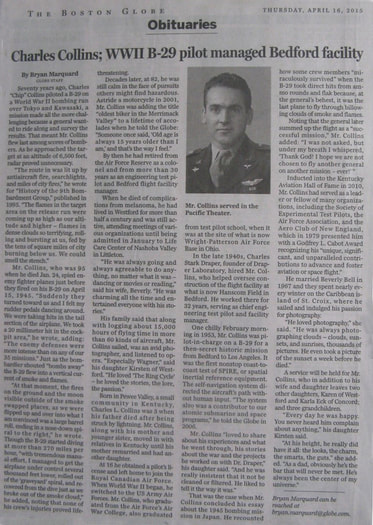 Charles R. Collins's grandson grew up to be a pilot during WW2. He was inducted into the Kentucky Aviation Hall of Fame in 2010.
Charles R. Collins's grandson grew up to be a pilot during WW2. He was inducted into the Kentucky Aviation Hall of Fame in 2010.
In 1915, the property was sold to Charles Robert Collins (May 7, 1860-October 17, 1939). The Collins family owned the house until 1941. Charles Collins was a native of Shelby County and a farmer. He was married twice, first to Frances Elizabeth Hunter on December 14, 1881, and the second time in 1922 to Ola S. Sampson in Oldham County.
The 1920 U.S. Census shows four people living in the house:
· C R Collins (Charles Robert Collins) 59
· H M Collins (son.....Hunter M.) 29
· Louise Collins daughter-in-law 22
· C L Collins grandson of Charles 9/12
Charles was working in real estate as well as partnering with his son, Hunter, on the farm. By the 1930 census, he had retired from farming. Only he, his second wife, his mother-in-law, and two servants, John and Polly Faylor, were living there. Hunter had died after he was struck by lightning around 1923:
· Charles R Collins 68
· Ola S Collins (wife) 48
· Sara T Sammons 75 (Mrs. Sam T. Sammons....Ola's mother)
· John Faylor Servant 76
· Polly Faylor Servant 68
Ola, though 20 years younger than her husband, died August 16, 1938 in Pewee Valley. Her husband died a year later on October 17, 1939 of pulmonary edema and is buried in Fairview Cemetery in Todds Point, Kentucky. Charles Collins’ will is reproduced below, courtesy of Oldham County Clerk Julie Barr. He evidently did not change it following his wife’s death:
I, C.R. Collins, of Pewee Valley, Oldham County, Kentucky, being of sound mind and disposing memory, do make and publish this my last will and estament, hereby expressly revoking any and all wills and testaments heretofore made by me.
First Clause: I desire that my debts and the cost of the administration of my estate be first paid.
Second Clause: I bequeath all of my guns to my grandson, Charles L. Collins, and I bequeath the old mantle clock to my granddaughter, Catherine P. Collins. Should either not be of age at my death the receipt for same of the persona having the custody of the infants shall be an aquittance under the Executrix.
Third Clause: I bequeath unto my beloved wife, Ola S. Collins, hereinafter referred to as the “Trustee”, the amount of Two Thousand ($2,000) dollars of General 5’s Louisville City Railway Bonds, six (6) shares of capital stock of the Crestwood State Bank, and two (2) shares of capital stock in the Pewee Valley State Bank, to be held by said Trustee in trust upon the following terms and conditions:
The income from said stocks and bonds shall be allowed to accumulate and from time to time added to the principal or invested. As each of my grandchildren, Charles L. Collins and Catherine P. Collins, respectively, arrive at the age of twenty-one years, one-half of said stocks and bonds and the accumulations thereof shall be paid over to them. Should either grandchild die before arriving at the age of twenty-one years, and if both the said grandchildren die before arriving at the age of twenty-one years the entire stocks and bonds shall pass as provided in the “Fourth Clause” of this will.
Fourth Clause: All the rest and residue of my estate of every description and kind, and wheresoever situated, I bequeath and devise in fee simple unto my beloved wife, Ola S. Collins.
Should she not survive me said residue shall pass in fee simple unto my issue, said issue per stirpes.
Fifth Clause: I hereby appoint my beloved wife Ola S. Collins as the Executrix of this will, and she is to be permitted to qualify as such without bond.
In testimony Whereof, I have this the 22 day of July 1932, subscribed hereto my signature and name, and have subscribed and acknowledged this will and testament in the presence of R.C. Jones and D. E. Wooldridge, who have, at my request subscribed the same with their names and in the presence of me and each other.
The 1920 U.S. Census shows four people living in the house:
· C R Collins (Charles Robert Collins) 59
· H M Collins (son.....Hunter M.) 29
· Louise Collins daughter-in-law 22
· C L Collins grandson of Charles 9/12
Charles was working in real estate as well as partnering with his son, Hunter, on the farm. By the 1930 census, he had retired from farming. Only he, his second wife, his mother-in-law, and two servants, John and Polly Faylor, were living there. Hunter had died after he was struck by lightning around 1923:
· Charles R Collins 68
· Ola S Collins (wife) 48
· Sara T Sammons 75 (Mrs. Sam T. Sammons....Ola's mother)
· John Faylor Servant 76
· Polly Faylor Servant 68
Ola, though 20 years younger than her husband, died August 16, 1938 in Pewee Valley. Her husband died a year later on October 17, 1939 of pulmonary edema and is buried in Fairview Cemetery in Todds Point, Kentucky. Charles Collins’ will is reproduced below, courtesy of Oldham County Clerk Julie Barr. He evidently did not change it following his wife’s death:
I, C.R. Collins, of Pewee Valley, Oldham County, Kentucky, being of sound mind and disposing memory, do make and publish this my last will and estament, hereby expressly revoking any and all wills and testaments heretofore made by me.
First Clause: I desire that my debts and the cost of the administration of my estate be first paid.
Second Clause: I bequeath all of my guns to my grandson, Charles L. Collins, and I bequeath the old mantle clock to my granddaughter, Catherine P. Collins. Should either not be of age at my death the receipt for same of the persona having the custody of the infants shall be an aquittance under the Executrix.
Third Clause: I bequeath unto my beloved wife, Ola S. Collins, hereinafter referred to as the “Trustee”, the amount of Two Thousand ($2,000) dollars of General 5’s Louisville City Railway Bonds, six (6) shares of capital stock of the Crestwood State Bank, and two (2) shares of capital stock in the Pewee Valley State Bank, to be held by said Trustee in trust upon the following terms and conditions:
The income from said stocks and bonds shall be allowed to accumulate and from time to time added to the principal or invested. As each of my grandchildren, Charles L. Collins and Catherine P. Collins, respectively, arrive at the age of twenty-one years, one-half of said stocks and bonds and the accumulations thereof shall be paid over to them. Should either grandchild die before arriving at the age of twenty-one years, and if both the said grandchildren die before arriving at the age of twenty-one years the entire stocks and bonds shall pass as provided in the “Fourth Clause” of this will.
Fourth Clause: All the rest and residue of my estate of every description and kind, and wheresoever situated, I bequeath and devise in fee simple unto my beloved wife, Ola S. Collins.
Should she not survive me said residue shall pass in fee simple unto my issue, said issue per stirpes.
Fifth Clause: I hereby appoint my beloved wife Ola S. Collins as the Executrix of this will, and she is to be permitted to qualify as such without bond.
In testimony Whereof, I have this the 22 day of July 1932, subscribed hereto my signature and name, and have subscribed and acknowledged this will and testament in the presence of R.C. Jones and D. E. Wooldridge, who have, at my request subscribed the same with their names and in the presence of me and each other.
Related Links:

